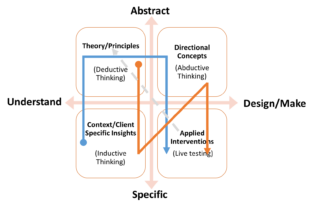How Do You Solve Fundraising Problems And Innovate?
Our bias on innovation is simple. True innovation comes from understanding people. The important question is how do you go about understanding people? What’s the method of thinking?
This rubric or matrix is our way of thinking about thinking and importantly, linking thinking to doing. And if it’s true that the meek borrow and genius steal, consider us at least half-genius with credit due to a Ruth Schmidt, Associate Professor of Behavioral Design at the IIT Institute of Design.
The left-hand side is thinking, right hand side is doing. Above the X axis is more abstract, below is more specific and concrete.
How do you navigate to the bottom right for testing?

Here are a few observations about the most common and unfortunately, least optimal paths, to thinking and doing. We’ll end with the ideal approach(es).
The “Nudge” Route
This is the top-down approach and it’s deductive thinking.
- A is B
- All B’s are C.
- Therefore, A is deductively, C
Deductive thinking by definition has no new findings in the conclusion, all the interesting bits are contained in the premise. It’s a very top-down approach that is often endemic to academics (ivory tower and all…) but also to those reading the pop-culture books on behavioral economics and trotting out ‘social proof’ or ‘identifiable victim’ as the principle to apply to the touchpoint/communication.

It’s better than a stick in the eye and light years better than jumping straight into the bottom right, ‘do’ mode but it can suffer from a perspective and framing problem as the theory and principles are often applied to a narrow understanding of the context. For example, the case of organ donation in the Scandinavian countries jumping from 10% (ish) to 90% (ish) almost overnight is trotted out as evidence of our “default-bias” and especially around opt-ins and opt-out. In this case, on Day 1 electing to be an organ-donor was an opt-in decision, the default was not being one. On Day 2 the default was changed to being an organ donor and you had to opt-out to not be. Whola, 90% election to be an organ donor.
Here’s the rub, when Person A died and the medical team was set to remove organs the family of Person A objected on the grounds that opt-out was not a legit expression of intent. The real goal and aim is getting new organs from donors into needy recipients. This didn’t solve that problem, it was too narrowly focused and lacking any contextual research or understanding of the larger needs.
The Insights/Data Analysis Route
This is the bottom up approach and it’s inductive thinking.
- Each time I do A under the same conditions, B occurs
- Inductively, the next time I do A under these conditions, B will occur.
This thinking has a conclusion that might be wrong because the premise is possibly flawed. This is all research and data analysis from surveys to modeling of our RFM data. Like deduction, there are no new findings contained in the logic of the argument, it’s observing what’s happened in a specific situation and forecasting that if you do it again, it will happen again.
If the sample is flawed, if the survey is flawed, if the analysis or number crunching is flawed then the whole logic train crashes, often expensively. This approach lacks any theoretical grounding or key principles or reason to believe other than the specific, narrow analysis.

Blue Sky Creative Route
In practice, this route is almost always relying on creative genius to intuit solutions to your problems. However, your creative genius is likely to explain that they engaged in lots of messy, involved, deep thinking to arrive at the brilliant, original concepts. If this happened (it didn’t because there was no starting point on the left hand side) then that’s abductive thinking.
- I’ve done something like A before but the circumstances weren’t exactly the same
- I’ve seen something like B before but the circumstances weren’t exactly the same
- I’m able to abduct that C is the reason B is occuring.
Abductive thinking is the logic of what might be. These are best-guesses using the information we have before us. It is digging in on cause and effect and the conclusion is always something new. 
Ideal Route(s) to Thinking and Doing
This may look and read a bit like a public transportation route map but bear with us.
The blue route: Trace from the starting point, round end cap to the ending arrow in the bottom right. This starts with context specific insights but is then informed by theory and principles to help sort and frame the findings. We then have the right mix of information to do abductive, cause-effect hypothesis development that is breaking new ground.
The orange route: Same as blue but different starting point – theory and principle first.
The gray dotted line: Consider this the institutional knowledge line. If our applied testing and interventions aren’t yielding generalizable findings that can be applied across channels and (perhaps) situations to grow our body of knowledge then it’s a tell-tale sign we didn’t follow the blue or orange line but instead, took one of the short-cut routes.

Kevin


